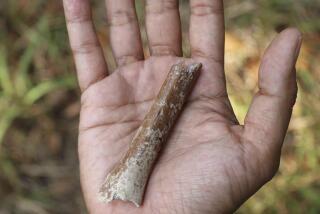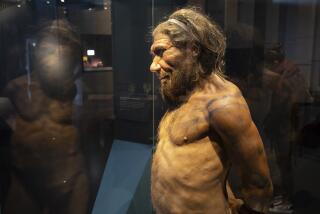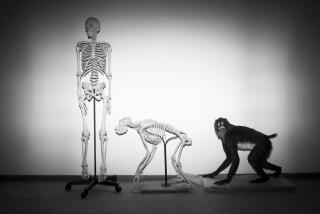Fossil Skull Could Change Theory of Human Origins
A newly discovered fossil skull suggests that an early human species migrated from Africa to Asia and back again before evolving into modern humankind, an international team of researchers said Wednesday.
The fossil is the strongest evidence yet that the species called Homo erectus--a tool-making, nomadic ancestor of humanity that was the first creature to master fire--was a single species ranging across Africa, Europe and Asia. Many scholars have argued in recent decades that Homo erectus was actually two or more species.
The discovery, unearthed in Ethiopia from the sediments of an ancient lake shore, will be detailed today in Nature magazine.
The new find is certain to revive scholarly arguments over a crucial period of human evolution, experts said. It appears to simplify the human family tree, but also to renew the debate over the role Asia may have played in human origins.
“What we now have is evidence that a single human ancestor species was so successful that it was spread from Java to Italy to Ethiopia by 1 million years ago,” said W. Henry Gilbert, a UC Berkeley graduate student who discovered the skull during a 1997 field expedition.
The find also highlights the crucial effect of climate change on human evolution.
The fossil skull belongs to a period when an abrupt climate change plunged the world into an ice age. These early humans had first evolved in Africa and then spread to Asia and Europe. As temperatures dropped across the Northern Hemisphere, they may have moved south back into Africa, as did many migrating herds in that era.
“This was a time . . . when there was large-scale movement of many species between continents everywhere on Earth due to major global climatic change,” said Yale University expert Elizabeth S. Vrba.
“They came out of Asia into Africa. They would have had to move to stay with water, to stay with food,” she said. “There would have been massive gene flow back and forth. That would get us the pattern we see--one single, widespread species.”
The evidence for the new theories consists of the skull and leg bones of six separate individuals that Gilbert and his colleagues found at a site along an arid outwash in the Middle Awash region of Ethiopia. The area is about 140 miles northeast of Addis Ababa.
Ethiopian and American researchers have turned up fossils of many prehuman and human ancestors there in recent years, including two previously unknown hominid species.
Gilbert was working in the 110-degree heat as part of a team of 45 scientists from 13 countries led by Ethiopian anthropologist Berhane Asfaw at the Rift Valley Research Service and UC Berkeley paleoanthropologist Tim D. White.
Scored by ancient fang marks and encrusted with fossilized roots, the skull needed three years of painstaking work to clean and restore.
“The new skull is gorgeous,” said anthropologist C. Owen Lovejoy at Kent State University, who has examined the find.
“The new specimen greatly simplifies our view” of how Homo erectus evolved, Lovejoy said. It paves the way “for new analyses of how and why erectus eventually gave rise to Homo sapiens.”
University of Tokyo anthropologist Gen Suwa called the 1-million-year-old fossil skull “well-preserved, undistorted and well-dated.”
‘It is the best we have in Africa in that time frame,” he said.
The fossils of these restless creatures have been bones of contention since the remains of the so-called “Java Man” were discovered in Asia more than a century ago. Decades of research and dozens of fossil finds in China, Europe and Africa have not settled how Homo erectus first evolved or clarified its contribution to contemporary humanity.
Although its bones first turned up in Asia, the oldest specimens of Homo erectus have been discovered in Africa, home to all the earliest known prehuman ancestors and universally considered the cradle of human evolution.
Homo erectus skulls vary widely. Those differences seemed so great that some scientists theorized that these human ancestors divided into two separate species between 1.5 million and 500,000 years ago.
Until now, researchers had gathered the African fossils into a separate species called Homo ergaster. The Asian fossils, they said, must belong to an isolated branch of the human family that likely had little or no direct contact with their African relatives after they split away. That branch, therefore, would have no connection to modern Homo sapiens.
Contemporary humanity, in that view, is an entirely African creation.
This primeval skull contradicts that theory, the researchers said.
If these early humans had diverged along separate evolutionary paths as they spread across the Old World, the new Ethiopian specimen should look quite different from its Asian relatives. Instead, the new skull is similar enough to some found in Asia to show that even after almost a million years of wandering, these creatures clearly all belonged to the same species.
That suggests there were substantial intermingling and interbreeding as these early humans migrated back and forth across the continents, the researchers said.
“The skull has features of both ‘Asian’ and ‘African’ forms,” said Asfaw. “This clearly shows that features previously considered to separate the Asian and African forms do not hold.”
Indeed, there is so little difference between those that lived in Africa and those that lived in Asia that any conclusions about the species’ birthplace are “premature,” the research team reported.
The new findings raise the possibility that this ancestor of humankind did not evolve solely in Africa as many scholars have believed, but with a significant contribution from Asia.
“It must have evolved [originally] from an African ancestor, but whether this ancestral species dispersed from Africa before it gave rise to Homo erectus--and whether this happened in Africa or Eurasia--are open questions,” said White at UC Berkeley.
Researchers hypothesize that the rapid cooling of the climate may have forced wandering bands of Homo erectus back into Africa and southern Europe. After it resettled there, however, the species continued to evolve. Eventually it split into several different species, again adapting to the changing climate, the researchers said.
Over time, the European branch of the erectus family became the Neanderthals who roamed Europe and the Middle East, White suggested. The Asian branch of the family eventually became extinct.
The African clan evolved into anatomically modern humans, then once more ventured out into the world.
(BEGIN TEXT OF INFOBOX / INFOGRAPHIC)
Branches of the Family Tree
Many anthropologists have believed that the fossil remains of Homo ergaster and Homo erectus represent two different species of early humans. But a discovery of fossils in Ethiopia that share characteristics of both types indicates the fossils are all from a single Homo erectus species that gave rise to modern humans and Neanderthals.
Homo erectus
1.8 million to 100,000 years ago
*
Homo sapiens
200,000 years ago
LATEST DISCOVERY:
*
Homo erectus
1 million to 800,000 years ago
*
Homo ergaster
2 million years ago
*
Homo neanderthal
230,000 to 29,000 years ago.
Photos courtesy of University of East Anglia, England; David L. Brill; AP; Institute of Human Origins; Tim D. White, Brill Atlanta






